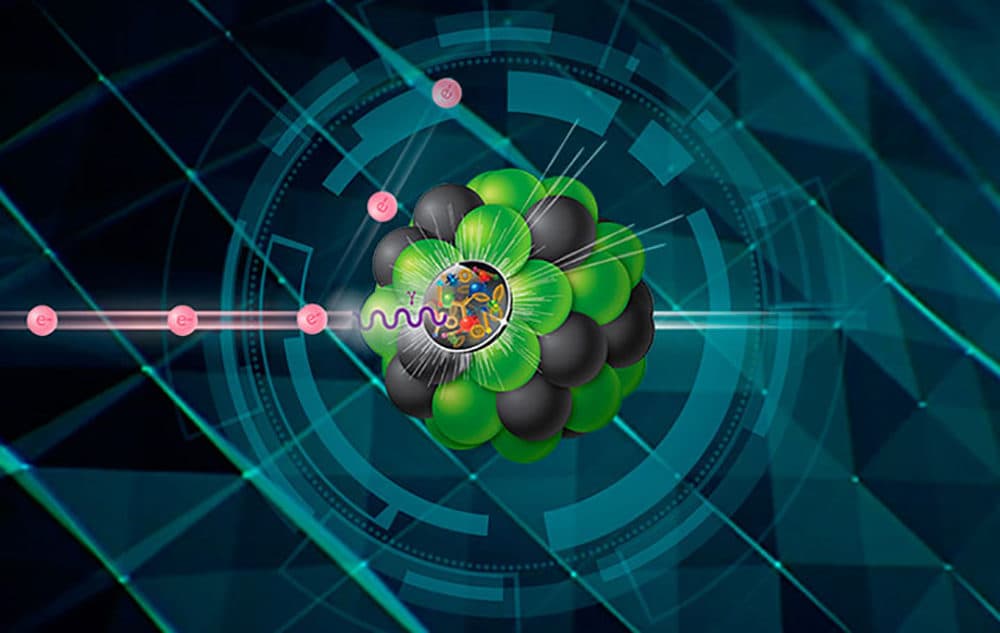Advertisement
New Particle Accelerator In New York To Probe Protons And Neutrons
Resume
The United States will soon have its first new particle collider in decades.
Earlier this year, the Department of Energy announced that Brookhaven National Laboratory in Upton, New York, will be home to the Electron-Ion Collider [EIC], which will investigate what’s inside two subatomic particles: protons and neutrons.
Brookhaven’s website describes this instrument as “a machine that will unlock the secrets of the strongest force in nature.” It’s essentially an electron microscope that shoots electrons at protons and neutrons in order to measure them, says Paul Dabbar, undersecretary for science at the Department of Energy.
“You need to accelerate it to very high levels of energy in order to basically shoot it, to do the mapping a little bit like an MRI or a CT scan for the inner workings of matter,” he explains.
The electron beam is accelerated very fast in a circle, Dabbar says.
“We will generate an electron beam and accelerate it to very, very close to the speed of light,” he says. “We basically circle around them imparting energy into the electron beam until it reaches the level that we want it so that we can image the protons and neutrons.”
Scientists can’t accelerate it exactly to the speed of light because as any piece of matter approaches that speed, its mass changes, Dabbar says.
“That mass change makes it increasingly hard to get faster and faster,” he says. “And as you reach the speed of light, you reach an infinite amount of energy needed to get to that last step, and therefore, we cannot do that.”

Interview Highlights
On the practical applications of this research
“Well, the basic science research that this country has done and we have led particle physics since World War II, since the Manhattan Project, and a lot of the technologies that we use today have come out of the basic research that came out of the national labs, including in physics. These accelerators can be used for many different things. The first one is medical isotopes that are used for cancer treatment. So I think as many people know, you look at nuclear medicine and nuclear imaging, which is a core part of the medical community right now for treating diseases, that these accelerators can produce those isotopes on the nuclear medicine side that are really critical. And many times you have to produce some very locally. You have to have accelerators around the country to make these isotopes because they decay relatively quickly, some of them. And so for us to move forward, that certainly helps the medical area.
“Another one, which is, I think, very interesting here in the near term, is around quantum information technologies. Utilizing quantum, which is inputting data into atoms rather than transistors, is basically a particle physics problem. And so the same equipment that we're looking at, technology that we're developing here and we've developed in the past for kind of older versions of accelerators, is the exact same particle technology that will be used for the upcoming quantum computing and the quantum internet.
“Another area is around detectors. The MRI machine came out of the DOE national nuclear physics work. And so we certainly expect that we will have improvements in MRI and CT machines from detectors just like when we helped invent them.”
On why this collider won’t be up and running until 2030
“So first of all, one of the advantages of this particular site and building it here is that we're actually using some existing collider infrastructure. There is a collider at Brookhaven National Lab right now called RHIC, which is a relativistic hadron collider. So there's already a loop there that it was accelerating other types of ions. There was an accelerator infrastructure [already] there. And so we're going to finish that mission in terms of imaging for nuclear physics in 2024. Between now and then, we're actually going to be starting both the engineering design in more detail as well as design around components like the accelerators. And then in 2024, when we take down the Rick Collider at Brookhaven National Lab, then we'll start actually installing. And so from then it will take about six years to both do the construction and then do the commissioning and startup.”
On why this is the first particle accelerator built in the U.S. in decades
“There's a bit of a history around these accelerators. They cost a lot of money. There was one that was looked at a couple of decades ago called the Superconducting Super Collider, which ran into some ... challenges. The U.S. decided to invest in CERN [the European Organization for Nuclear Research] and the Large Hadron Collider in Geneva for that particular piece of science. We've been focusing on other areas. So one of them has been a neutrino piece of infrastructure at Fermilab outside of Chicago.
“We've been investing in Europe for some colliders over the last, you know, the near term. And by the way, we continue that is for that particular type of collider. We're increasing our investment by the United States into the European collider at CERN. But we decided to take a look at building this particular collider in the U.S. I think a key thing for your listeners to kind of understand is that the budgets for the Office of Science and science in general at the federal level, including NASA and the National Science Foundation and National Institutes of Health, are at all-time highs, and we're very excited about the support that, very bipartisan support from both Congress and ultimately president signing the budgets for all-time highs. So we're very excited about that.”
Chris Bentley produced and edited this interview for broadcast with Kathleen McKenna. Samantha Raphelson adapted it for the web.
This segment aired on February 12, 2020.
